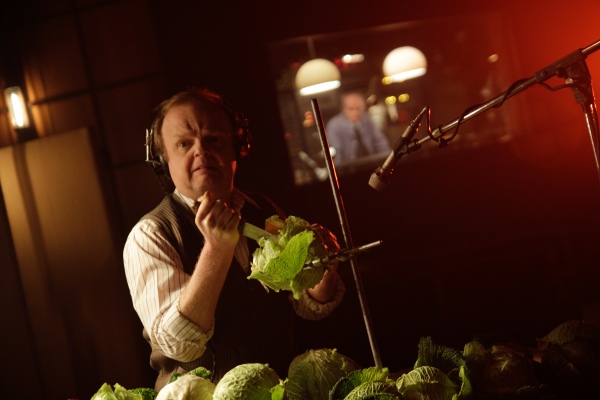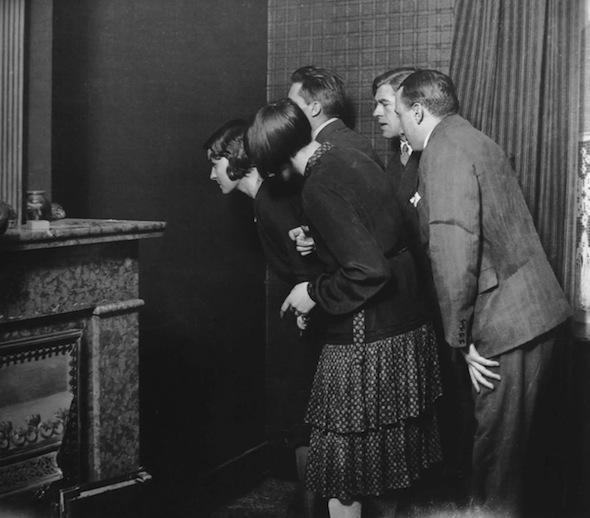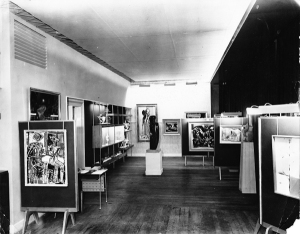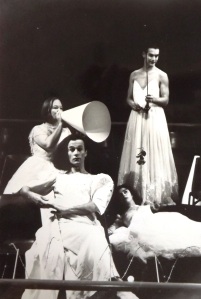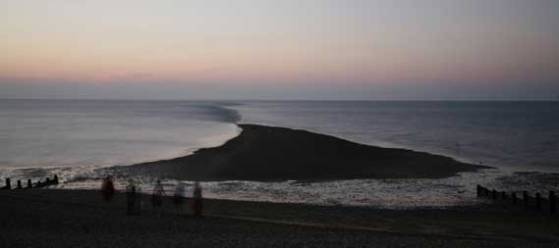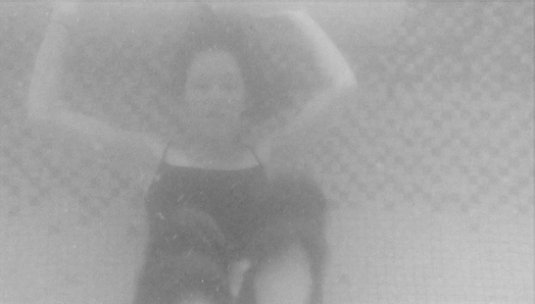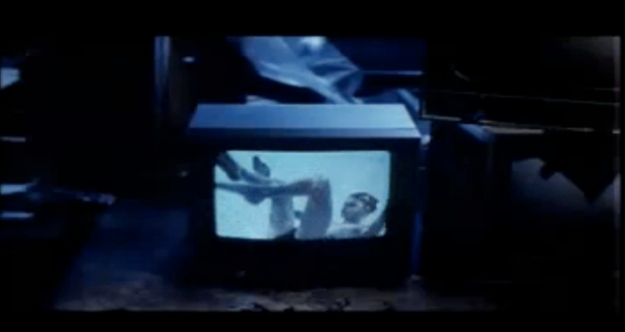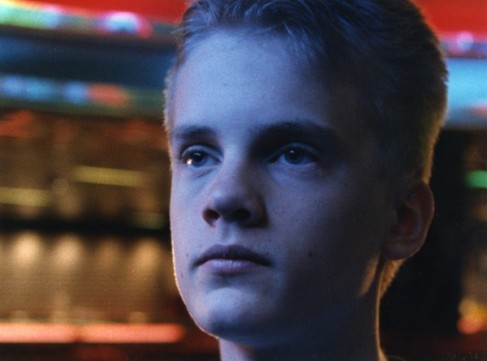Peter Strickland’s Berberian Sound Studio: ‘the logic of the visible at the service of the invisible.’
This article was written prior to a talk Peter Strickland gave at the ICA as part of the BAFTA masterclass series.
by Seth Pimlott
There are many arresting scenes in Peter Strickland’s lovingly made Berberian Sound Studio, but there is one that delivers a psychic and almost physical blow. Although it’s a film apparently concerned with the ingenuity of sound engineers and foley artists tasked with the production of sound effects back in analogue time, this rupture suggests something else is going on. We initially follow Gilderoy, a British sound engineer cast in the rough mold of a diffident radio workshop boffin from his arrival at an Italian film studio where he has been hired to soundtrack the absurdly named, sexploitation gore-fest Equestrian Vortex. Strickland sets up a carefully handled narrative that posits Gilderoy as a spectator of this kind of hammy, rumbustious Roman world, poked and bullied around by the director, Santini and his imposing assistant. We have the growing sense that Santini has a sleazy second agenda; to entrap the assorted cast of beautiful women, vocal artists, and Gilderoy in his own sadistic little game. A central scene drastically undermines our belief in the fiction that has previously been established and it is the weirdness of the film, initiated halfway through and sustained until the end that I want to talk about. Both this central scene and the final episode have a very unnerving, disorientating affect, one that derives its force from surrealist poetics.
One of the first scenes introduces us to the central character Gilderoy and the work that he will be undertaking. He arrives at the film studio, where Gilderoy is introduced to the director’s assistant who shows a rough cut of the film that he will work on. We watch them as they watch the film. This cuts to the title sequence of Santini’s, ‘The Equestrian Vortex’, the only part of the movie we’re allowed to see. The sequence, masterfully produced by the graphic designer Julian house (who was also responsible for all the other design work throughout the film and its promotion, http://andyhague.blogspot.co.uk/2012/09/julian-house.html)) gives a sense of the movie that we’re never shown. A Giallo shocker, psychedelic lashings of scarlet blood and human tissue dribble down fracturing silhouettes of the fictional cast while the credits role. We presume the film has started and we cut back to a shot of a perturbed Gilderoy and the assistant watching what must be a blood-bath, ‘Is that entirely necessary…What is he doing to her… and it doesn’t seem to be about horses?’ Gilderoy then grudgingly accepts a slice of watermelon from a beardy studio-hand, introducing us to the material that Gilderoy will work with – namely soggy fruit and veg.
Berberian Sound Studio is, among other things, a meditation on the lost art of physical sound making. Gruesome scenes find their sonic equivalent through Gilderoy’s ingenious use of groceries. The whip of a blanket followed by smashing a marrow on the floor becomes the sound of the defenestration of a witch, a cabbage vigorously dunked in a tub soundtrack a brutal murder in a vat of boiling water, the sizzle of oil on a frying pan simulates the sexual assault of an amorous Goblin using a red hot poker. Gilderoy is also shown to be in complete control of his art – a power cut at the studio prompts him to display a delicate inventiveness: a light bulb rolled over a toast rack becomes a UFO.
In one of the many references to the wizardry of tape and the machines used to manipulate it, Gilderoy loops the actress Sylvia’s voice into a hauntingly beautiful soundscape using a delicious bit of equipment called a Watkins Copycat. There is a real love of the matter and mystery of these perfectly designed bits of kit, and the camera often interrupts the film to linger on a deeply satisfying circular mixing knob, or spool of tape (infact, there is a circular repetition throughout – gong, spool of tape, frying pan, eyeball.) There is a formal visual game going on that has its apotheosis in the final scene, but there is also a pleasure taken in these things in and of themselves. The film celebrates the wonders of sound production, and a different analogue method of old school movie making. However the disjoint between material, sound and image, fits into another theme that Berberian Sound Studio confronts – the basic deceit of filmmaking.
The first half of the film suggests continuity of space and time, but only through inviting the audience to make a series of assumptions without evidence. The story plays out in three different spaces – the studio, the corridors connected to it and Gilderoys’ flat (where he takes home his work). There seems to be a logic but we’re never carried with a character from one space to the next. Rather, certain objects provide the link as we segue from one scene to the next: a spider in Gilderoy’s bedroom cuts to a spider a crawling over an organ in the studio, an open cabinet door in the in the studio cuts to an open wardrobe in Gilderoy’s bedroom. These transitions hint at a more radical transgression of space and time that marks the switch from character motored thriller to a more abstract engagement with the nature of film that occurs later on.
The central scene finally breaks the narrative flow – what had previously felt uneasy becomes drastically confusing. Gilderoy is asleep in his bedroom, where he is woken up by someone ringing at the doorbell. He asks who it is, picks up a knife and moves towards the door, attempting to open it there is a struggle. Someone on the other side is preventing him from forcing it open. He finally manages to shunt the door open and stumble through, but rather than moving outside Gilderoy steps into the deserted studio. The film’s straightforward spatial logic is overturned. A film projector turns on, and we watch Gilderoy watch himself in the scene that we have just observed: he sees himself rise from his bed, grab the knife, call out and then move towards the door. As Gilderoy’s image tries to turn the doorknob, the studio door that he has just walked through rattles. Gilderoy rushes over to prevent the projected image of himself breaking in; the terror is of having to deal with this animated double. The film then cuts to an accomplished, abstract scratch film with layered shots of Gilroy’s image gradually falling apart, before the film emulsion itself disintegrates. The rest of the film develops from this moment of fracture.
This scene feels unnerving for more than just its illogicality. What is perturbing is not just the way it undermines everything that we’re moved to believe in the film, but the way it provokes the effect of, ‘watching oneself watch oneself’. I was reminded of it a few days later when I came cross this photograph by the Belgian surrealist Paul Nouge. Titled ‘The Birth of an Object’, it is one from a series made in 1931 called, Les Subversion Des Images. Nouge’s caption for this photo reads:
A group of people watching something particularly attractive and precisely located. An ordinary wall is substituted for what they look at.
This image seemed to resonate with the central scene in Berberian Sound Studio. Partly there is a humour to the photo, and Berberian Sound studio, for a film that is ultimately reflective and serious, makes you laugh a lot. The birth of an object implies a portentous seriousness that it then undercuts, but nevertheless it is in the joke that you grasp Nouge’s argument.
Nouge was a badge-wearing signatory of Andre Breton’s second Surrealist Manifesto in 1929. For surrealists, photography made the straightforward plastic expression of what we see redundant; therefore the sole domain of art became pure mental representation. However, if they agreed about the ambition to make manifest the process and content of internal perception, they disagreed about the methods that might reveal these phenomena.
For Breton and the artists and writers around him, ‘pure psychic automatism’ held the key. They hoped to evade conscious censorship in order to liberate un-doctored, unconscious desires, The primary technique was the acceleration of the speed of writing which was believed to elicit a flow of mysteriously linked images ‘In the absence of control by reason’. They were interested in the ‘honest’ writing produced by naive, marginalised authors like the mentally ill or children. They thought it was possible to discover the product of the unmediated psyche: it was already out there in places no one had bothered to look, and all it required was a novel – and rhetorically abusive – mode of expression.
By contrast, Nouge (a chemical engineer by profession) represented a different, almost scientific and logical strand of surrealism. For him the escape towards a new artistic reality was attainable in the presence of the, ‘control of reason’. His work was influenced by the work of the poet Paul Valery and linguistic theorist Jean Paulhan who both argued that there was a profound disconnect between thought and language, and that therefore the automatic methods of the French surrealists were bound to fail. If Breton believed that automatic writing could dismantle or bypass the arbitrary rhetoric or rules of language, Paulhan argued that this was pointless – by using any language at all you were already snared: once bound within language, you couldn’t trick any superior veracity or authenticity out of it. In his essay “Young Lady with Mirrors,” Paulhan comes to the paradoxical conclusion that the more we attempt to fix language, the more elusive it becomes: “A man can no more grasp his mind intact than he can directly see the nape of his neck or throat. There are, however, mirrors for seeing the back and front of the neck. But there are none for the mind.”
From this point of view the poem or work of art could never be the pure expression or thought of the artist because it was the result of a collaboration between artist and audience that relied on a system of communication that existed beyond both. Consequently the only way of creating critical new expression was to embrace the rules and rhetoric of languages. For Paulhan, ‘The honest poem is the poem that acknowledges its dishonesty’, one that is self reflexive about the rules of poetic construction, confronting the poet and reader with the sensation of, ‘watching oneself watch oneself.’ Although for these writers there was an unbridgeable gap between the word and the world, poetry could make manifest a kind of parallel structure, a shared set of rules between the two. They were distinct systems whose constituent parts remained immanent to their own individual spheres; however the internal relations of one could be understood in relation to the internal relations of the other.
Nouge went one step further. Language and the arbitrary signs that aided communication were more than just an intermediary between two interlocutors, they existed in their own right, having their own, almost organic, life in the world beyond the will of author and audience. This ‘reality’ that subsumed both the rules of language and the operation of thought might be revealed when the rules that govern the medium were embraced, but then pushed to the limit of reason where they would collapse. Nouge was not interested in art as a means of expressing human experience, but rather he turns to a more scientific approach where you systematically manipulate signs to the point where momentarily the otherwise unbridgeable gap between word and ‘the real’ is breached. At this moment, which he labels ‘terror’, the conventional structures of the language system you’re working with (text, photography, film) are turned inside out. The idea is that you simultaneously recognise the manipulations involved in language, yet glimpse a reality that supersedes them. Proceeding in logical steps as far as logic will permit, for Nouge it becomes possible to perceive, ‘a ‘visual phenomenon which we believe exists beyond ourselves; a thought, an emotion which we perceive as existing within us.’ This is what is attempted in Les Subversions des Images, and seems directly relevant to the film.
The Birth of an Object’s oddness derives in part from its straightforward adoption of the conventions of photography. As with the rest of the series, Nouge stresses the normality of the photo being taken; he is working within the taken-for-granted’s that delineate the way we expect a photo to be approached, the camera as automatic machine recording ‘fact’ without ‘fantasy’. In addition he is playing with the mores of petit – bourgeois, domestic existence. Everything appears in front of the camera as normal, a suburban interior, where the actors are absorbed by their activity. Like any old photograph, we are witness to something apparently quotidian and boring- it could be a photograph of an after dinner event, a slightly deranged evening with the new neighbours.
There is nothing to see here apart from one very strange thing. The object the group stare at is missing. But it is the complexity of its absence that is jarring. Nouge has removed the object from its context and replaced it by a wall. Rather than a simple omission defined in terms of absence or presence, our attention is focused on an absence that resists easy symbolisation – that can’t be defined in opposition to its positive, present, other. The words of the symbolist painter Odilon Redon could be used to describe Nouge’s method and ambition: putting ‘The logic of the visible at the service of the invisible.’ It is through the logical, systematic twist and push of an idea of absence that the photo has its effect. It is this that produces for the spectator an unusual, slightly ridiculous shock. Nouge brings you up short against you’re expectations, and in doing so attempts to affect a reality that is inconceivable, in his words, ‘Inventing a universe and not describing it.’
The photo alerts you to the mediums dishonesty, testing our faith in pictures. You’re brain scrambles to find meaning that’s not there. But the Birth of an Object also establishes a loop. We look at a photograph of a group of people staring at something that isn’t there, which reminds us that we are in a similar position. The internal relations of the photograph correspond to the relations set up between the spectator and the photograph. The indefinable absence within image alerts us to the indefinable absence of the image –its dishonesty – where the caption describes both the reality we inspect within the photograph, and the experience of viewing it, as unresolvable. The same kind of self-reflexive loop is established in Berberian Sound Studio.
However, in the film this process is far more troubling because the flow of moving images induces a far greater power of identification and involvement than that of photography or literature. Strickland takes advantage of this passive acceptance, lulling you into a set of expectations derived from the rhetoric of conventional filmic narrative, space and time only in order to upset them. Gilderoy’s movement from apartment to studio is the first of these transgressions. A pre-existing, natural space and time is not being imitated, rather what we witness is merely the space of an encounter unique to film. The concern here is with the matter of film at the expense of reality – what you can capture and create with film and only film. Gilderoy then turns to watch himself in the scene that has just played out in his apartment. If in Nouge’s photograph the group stare at a static object that is radically not there, in the film Gilderoy identifies with the illusion of his own character constructed from a flicker of light – cinema.
It is not just representation that is being challenged, but the psychological and emotional process of our identification with a fiction in film. Rather than use identification to involve us in a representation, Strickland (by no means the first to walk off this plank) exposes its mechanics to our scrutiny. It is a move from the usual goal of inspiring belief in a fiction ‘behind’ the image, to one that focuses our attention on the properties of the image itself – the projected illusion of a presence that is radically absent. There is no opposition or difference between the film image and what it expresses. In a way it’s a bit monstrous, it entices you into a film world that you think you understand – before showing you that it’s a film world that works according to its own rules, and that it exists in its own separate domain beyond our habitual conceptual parameters. It induces a queasy existential state that is quite exciting and curious, that your own involvement with the film as shown to you in the film can only collapse, leaving a kind of mystery in its wake. That this central scene then cuts to a startling scratch film of physically manipulated footage underscores a preoccupation with a reality that film alone can produce.
Up to the central scene Gilderoy appears to be the ‘victim’ of the film – but after it he becomes a cog in its machine. The action takes place in a much more confounding cinematic world than that posited initially, and is overdubbed in Italian with English subtitles. There is a residual narrative thread, for instance there is some relationship between Gilderoy’s life at home, a letter he receives from his mother that details the grisly end to a nesting family of chaffinches in his shed, and the dodgy goings on in the studio, but it feels ancillary to the real work being done.
The final episodes seem to show Gilroy now, apparently in ‘control’ of what we see and hear. We find ourselves in his apartment when he then turns a reel-to-reel tape machine off. With it, the diegetic sound also switches off, and the film goes quiet. Although there has been a constant play between the images we see and Gilderoy’s innovative sound making, this is another way of alerting us to the kind of blatant manipulation that is going on. If this Gilderoy had originally been resistant to Santini’s claustrophobic film world before the central rupture, afterwards he has apparently become the film’s accomplice.
Next we see Gilderoy asleep, while a recently hired vocal artist creeps up to his bed and attacks him. It is not clear which of them comes out on top in the struggle. Then we segue to what is apparently the very first scene of the film again: Santini’s assistant introducing Gilderoy to the film that he will work on – The Equestrian Vortex. The shots are the same, the dialogue is the same, and Gilderoy repeats himself, ‘It doesn’t seem to be about horses.’ We can see them, but for the first time we can also see what they’re watching – the rough cut of The Equestrian Vortex – a privilege we haven’t been afforded before. The scene within the scene shows the struggle between Gilderoy and the actress at his apartment play out again, before the image of Gilderoy stabs her manically. The last moments of this scenario replicate the structure of the central scene, but map it back onto the first, rather innocent, opening of the film. Facing the screen Gilderoy repeats his naïve ‘what’s he doing to her?’ Gilderoy balks at the heinous murder being committed, but fails to recognise himself as the murderer. Identification has now exhausted itself completely, the actor on screen is reduced to his own effigy, and his effigy has stolen his mind. It produces further loop, implying the possibility that our sense of ‘self’ may have been kidnapped by a set of images and dispositions we construct, then blindly, and habitually act out.
In the final scene Gilderoy is subsumed by a dot of projected white light that gradually engulfs him, by extension his incipient psychology, and then the entire screen. The projection of light is ominous and inexplicable – not symbolic. Any remaining trust in the previous reality of space and time and character is overwhelmed by a mysterious and all engulfing shape that first arises out of and finally takes over the narrative world posited at the start of the film.
Both Nouge and Strickland are playing a surrealist, rhetorical game; their impact in part the result of folding the conventions of the respective mediums they work with back onto themselves. This process is crucial to the impact of the central and final scenes in Berberian Sound Studio. What is revealed is the startling capacity of film image, not to imitate, but to create and capture an alternative reality, disrupting our passive acceptance and identification with a hallucinatory play of light. The ‘terror’ one feels is not simply the sensation of exposure to something extreme, it has been produced at the point where rhetorical manipulation of the commonplace conventions of film language becomes its’ opposite. At this point there is a mystery, it resists interpretation. Berberian Sound Studio, in a true surrealist way, does not leave you where you were but picks you up and leaves you ‘elsewhere’.

